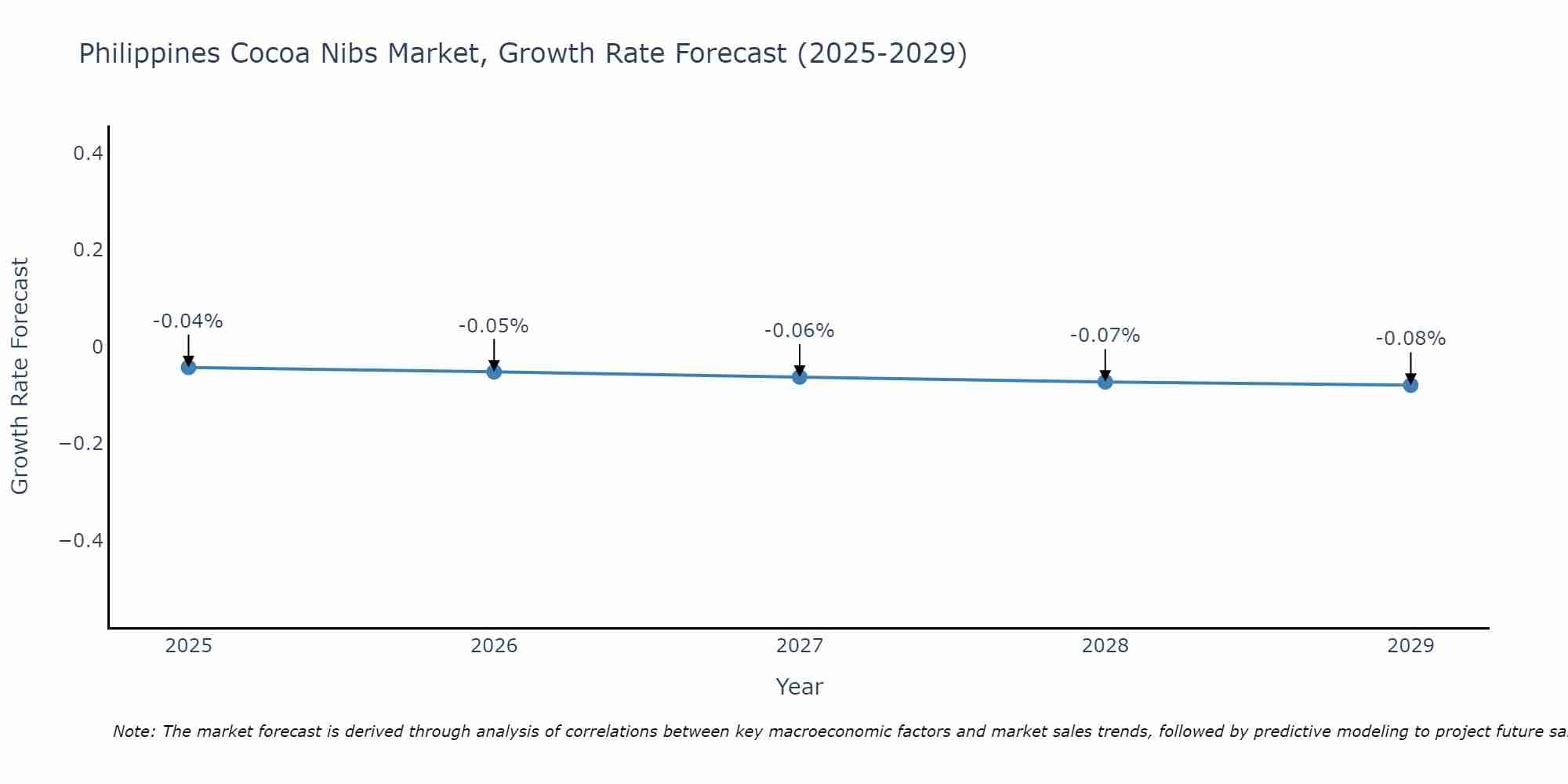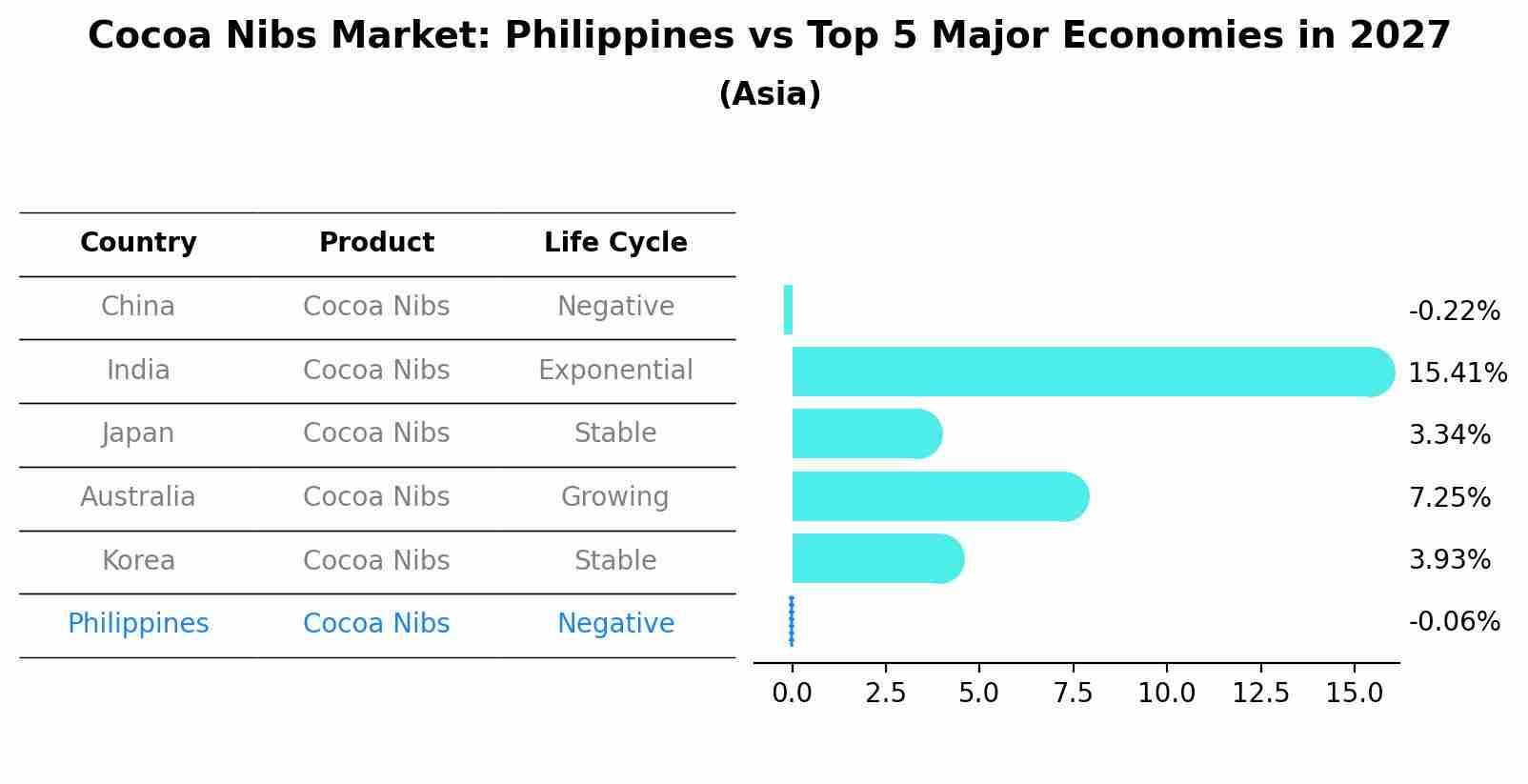Philippines Cocoa Nibs Market (2025-2031) Outlook | Companies, Forecast, Growth, Value, Industry, Trends, Size, Revenue, Analysis & Share
| Product Code: ETC107268 | Publication Date: Jun 2021 | Updated Date: Apr 2025 | Product Type: Report | |
| Publisher: 6Wresearch | No. of Pages: 70 | No. of Figures: 35 | No. of Tables: 5 | |
Philippines Cocoa Nibs Market Size Growth Rate
The Philippines Cocoa Nibs Market could see a tapering of growth rates over 2025 to 2029. Although the growth rate starts strong at -0.04% in 2025, it steadily loses momentum, ending at -0.08% by 2029.

Cocoa Nibs Market: Philippines vs Top 5 Major Economies in 2027 (Asia)
The Cocoa Nibs market in Philippines is projected to grow at a negative growth rate of -0.06% by 2027, within the Asia region led by China, along with other countries like India, Japan, Australia and South Korea, collectively shaping a dynamic and evolving market environment driven by innovation and increasing adoption of emerging technologies.

Philippines Cocoa Nibs Market Synopsis
The cocoa nibs market size in the Philippines was estimated to be nearly USD 4 Million in 2025 and it is anticipated that it will grow with a CAGR rate of 9%. This growth can be attributed to rising awareness regarding healthy dietary habits coupled with increasing disposable incomes driving consumption levels across all demographics groups throughout the country. Moreover, advancements towards healthier snacks have also driven product popularity among consumers. On top of that, developing infrastructure along with technological innovations have led to increased availability leading further augmenting overall demand.
Drivers of the market
The Philippines cocoa nibs market, involving the processing of cocoa beans into small pieces, is driven by several key drivers. One significant driver is the increasing demand for natural and minimally processed food products. Cocoa nibs are known for their rich cocoa flavor and potential health benefits, making them a popular ingredient in various food and beverage applications. As consumers seek healthier snacking options and flavorful additions to their diets, the demand for products containing cocoa nibs is expected to grow. Furthermore, the use of cocoa nibs in confectionery, baking, and culinary creations contributes to the expansion of the market, driven by the popularity of cocoa-infused flavors.
Challenges of the market
The Philippines cocoa nibs market, focusing on the processing of cocoa beans, could encounter challenges related to agricultural practices, quality control, and market competition. Ensuring consistent cocoa bean quality through proper fermentation and drying techniques is essential for producing high-quality nibs. Market competition from global cocoa suppliers and price fluctuations in the cocoa market could influence the profitability of local producers.
Covid-19 Impact of the market
The Philippines cocoa nibs market encountered challenges due to the COVID-19 pandemic. Cocoa nibs are used in the food, beverage, and confectionery industries. The disruptions in supply chains, reduced production of certain foods, and shifts in consumer behavior influenced the demand for cocoa nibs-containing products. While the confectionery and bakery sectors maintained essential demand, challenges in sourcing raw materials affected availability. However, as the situation improves and consumer preferences stabilize, the cocoa nibs market is anticipated to recover. The market`s revival will be driven by the resumption of food and confectionery production.
Key Players of the market
The Philippines cocoa nibs market, related to the cocoa and confectionery industries, might feature key players like Theo & Philo Artisan Chocolates Philippines. This brand specializes in premium chocolates, including products made from cocoa nibs. Another notable participant could be Auro Chocolate Philippines, contributing to the market with its sustainable and ethically sourced cocoa products, shaping the availability of cocoa nibs for chocolate enthusiasts.
Key Highlights of the Report:
- Philippines Cocoa Nibs Market Outlook
- Market Size of Philippines Cocoa Nibs Market, 2024
- Forecast of Philippines Cocoa Nibs Market, 2031
- Historical Data and Forecast of Philippines Cocoa Nibs Revenues & Volume for the Period 2021-2031
- Philippines Cocoa Nibs Market Trend Evolution
- Philippines Cocoa Nibs Market Drivers and Challenges
- Philippines Cocoa Nibs Price Trends
- Philippines Cocoa Nibs Porter's Five Forces
- Philippines Cocoa Nibs Industry Life Cycle
- Historical Data and Forecast of Philippines Cocoa Nibs Market Revenues & Volume By Product for the Period 2021-2031
- Historical Data and Forecast of Philippines Cocoa Nibs Market Revenues & Volume By Conventional for the Period 2021-2031
- Historical Data and Forecast of Philippines Cocoa Nibs Market Revenues & Volume By Organic for the Period 2021-2031
- Historical Data and Forecast of Philippines Cocoa Nibs Market Revenues & Volume By Application for the Period 2021-2031
- Historical Data and Forecast of Philippines Cocoa Nibs Market Revenues & Volume By Commercial for the Period 2021-2031
- Historical Data and Forecast of Philippines Cocoa Nibs Market Revenues & Volume By Household for the Period 2021-2031
- Philippines Cocoa Nibs Import Export Trade Statistics
- Market Opportunity Assessment By Product
- Market Opportunity Assessment By Application
- Philippines Cocoa Nibs Top Companies Market Share
- Philippines Cocoa Nibs Competitive Benchmarking By Technical and Operational Parameters
- Philippines Cocoa Nibs Company Profiles
- Philippines Cocoa Nibs Key Strategic Recommendations
Frequently Asked Questions About the Market Study (FAQs):
1 Executive Summary |
2 Introduction |
2.1 Key Highlights of the Report |
2.2 Report Description |
2.3 Market Scope & Segmentation |
2.4 Research Methodology |
2.5 Assumptions |
3 Philippines Cocoa Nibs Market Overview |
3.1 Philippines Country Macro Economic Indicators |
3.2 Philippines Cocoa Nibs Market Revenues & Volume, 2021 & 2031F |
3.3 Philippines Cocoa Nibs Market - Industry Life Cycle |
3.4 Philippines Cocoa Nibs Market - Porter's Five Forces |
3.5 Philippines Cocoa Nibs Market Revenues & Volume Share, By Product, 2021 & 2031F |
3.6 Philippines Cocoa Nibs Market Revenues & Volume Share, By Application, 2021 & 2031F |
4 Philippines Cocoa Nibs Market Dynamics |
4.1 Impact Analysis |
4.2 Market Drivers |
4.3 Market Restraints |
5 Philippines Cocoa Nibs Market Trends |
6 Philippines Cocoa Nibs Market, By Types |
6.1 Philippines Cocoa Nibs Market, By Product |
6.1.1 Overview and Analysis |
6.1.2 Philippines Cocoa Nibs Market Revenues & Volume, By Product, 2021-2031F |
6.1.3 Philippines Cocoa Nibs Market Revenues & Volume, By Conventional, 2021-2031F |
6.1.4 Philippines Cocoa Nibs Market Revenues & Volume, By Organic, 2021-2031F |
6.2 Philippines Cocoa Nibs Market, By Application |
6.2.1 Overview and Analysis |
6.2.2 Philippines Cocoa Nibs Market Revenues & Volume, By Commercial, 2021-2031F |
6.2.3 Philippines Cocoa Nibs Market Revenues & Volume, By Household, 2021-2031F |
7 Philippines Cocoa Nibs Market Import-Export Trade Statistics |
7.1 Philippines Cocoa Nibs Market Export to Major Countries |
7.2 Philippines Cocoa Nibs Market Imports from Major Countries |
8 Philippines Cocoa Nibs Market Key Performance Indicators |
9 Philippines Cocoa Nibs Market - Opportunity Assessment |
9.1 Philippines Cocoa Nibs Market Opportunity Assessment, By Product, 2021 & 2031F |
9.2 Philippines Cocoa Nibs Market Opportunity Assessment, By Application, 2021 & 2031F |
10 Philippines Cocoa Nibs Market - Competitive Landscape |
10.1 Philippines Cocoa Nibs Market Revenue Share, By Companies, 2024 |
10.2 Philippines Cocoa Nibs Market Competitive Benchmarking, By Operating and Technical Parameters |
11 Company Profiles |
12 Recommendations |
13 Disclaimer |
- Single User License$ 1,995
- Department License$ 2,400
- Site License$ 3,120
- Global License$ 3,795
Search
Related Reports
- ASEAN Bearings Market (2025-2031) | Strategy, Consumer Insights, Analysis, Investment Trends, Opportunities, Growth, Size, Share, Industry, Revenue, Segments, Value, Segmentation, Supply, Forecast, Restraints, Outlook, Competition, Drivers, Trends, Demand, Pricing Analysis, Competitive, Strategic Insights, Companies, Challenges
- Europe Flooring Market (2025-2031) | Outlook, Share, Industry, Trends, Forecast, Companies, Revenue, Size, Analysis, Growth & Value
- Saudi Arabia Manlift Market (2025-2031) | Outlook, Size, Growth, Trends, Companies, Industry, Revenue, Value, Share, Forecast & Analysis
- Uganda Excavator, Crane, and Wheel Loaders Market (2025-2031) | Strategy, Consumer Insights, Analysis, Investment Trends, Opportunities, Growth, Size, Share, Industry, Revenue, Segments, Value, Segmentation, Supply, Forecast, Restraints, Outlook, Competition, Drivers, Trends, Demand, Pricing Analysis, Competitive, Strategic Insights, Companies, Challenges
- Rwanda Excavator, Crane, and Wheel Loaders Market (2025-2031) | Strategy, Consumer Insights, Analysis, Investment Trends, Opportunities, Growth, Size, Share, Industry, Revenue, Segments, Value, Segmentation, Supply, Forecast, Restraints, Outlook, Competition, Drivers, Trends, Demand, Pricing Analysis, Competitive, Strategic Insights, Companies, Challenges
- Kenya Excavator, Crane, and Wheel Loaders Market (2025-2031) | Strategy, Consumer Insights, Analysis, Investment Trends, Opportunities, Growth, Size, Share, Industry, Revenue, Segments, Value, Segmentation, Supply, Forecast, Restraints, Outlook, Competition, Drivers, Trends, Demand, Pricing Analysis, Competitive, Strategic Insights, Companies, Challenges
- Angola Excavator, Crane, and Wheel Loaders Market (2025-2031) | Strategy, Consumer Insights, Analysis, Investment Trends, Opportunities, Growth, Size, Share, Industry, Revenue, Segments, Value, Segmentation, Supply, Forecast, Restraints, Outlook, Competition, Drivers, Trends, Demand, Pricing Analysis, Competitive, Strategic Insights, Companies, Challenges
- Israel Intelligent Transport System Market (2025-2031) | Strategy, Consumer Insights, Analysis, Investment Trends, Opportunities, Growth, Size, Share, Industry, Revenue, Segments, Value, Segmentation, Supply, Forecast, Restraints, Outlook, Competition, Drivers, Trends, Demand, Pricing Analysis, Competitive, Strategic Insights, Companies, Challenges
- Uganda Precast and Aggregate Market (2025-2031) | Strategy, Consumer Insights, Analysis, Investment Trends, Opportunities, Growth, Size, Share, Industry, Revenue, Segments, Value, Segmentation, Supply, Forecast, Restraints, Outlook, Competition, Drivers, Trends, Demand, Pricing Analysis, Competitive, Strategic Insights, Companies, Challenges
- Australia IT Asset Disposal Market (2025-2031) | Strategy, Consumer Insights, Analysis, Investment Trends, Opportunities, Growth, Size, Share, Industry, Revenue, Segments, Value, Segmentation, Supply, Forecast, Restraints, Outlook, Competition, Drivers, Trends, Demand, Pricing Analysis, Competitive, Strategic Insights, Companies, Challenges
Industry Events and Analyst Meet
Our Clients
Whitepaper
- Middle East & Africa Commercial Security Market Click here to view more.
- Middle East & Africa Fire Safety Systems & Equipment Market Click here to view more.
- GCC Drone Market Click here to view more.
- Middle East Lighting Fixture Market Click here to view more.
- GCC Physical & Perimeter Security Market Click here to view more.
6WResearch In News
- Doha a strategic location for EV manufacturing hub: IPA Qatar
- Demand for luxury TVs surging in the GCC, says Samsung
- Empowering Growth: The Thriving Journey of Bangladesh’s Cable Industry
- Demand for luxury TVs surging in the GCC, says Samsung
- Video call with a traditional healer? Once unthinkable, it’s now common in South Africa
- Intelligent Buildings To Smooth GCC’s Path To Net Zero













